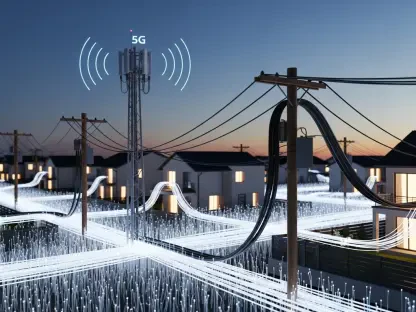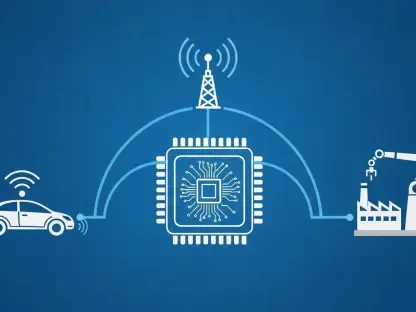Imagine a rural community where students struggle to join online classes, small businesses miss out on digital markets, and telemedicine remains a distant dream due to unreliable internet—a scenario that is still a reality for millions across the United States, despite significant federal efforts to close the digital divide. The Broadband Equity, Access, and Deployment (BEAD) program, a cornerstone of national broadband policy, aims to address these gaps by funding infrastructure in unserved and underserved areas. This roundup gathers diverse opinions and insights from industry stakeholders, state officials, and technology analysts to explore why fiber-optic technology remains the top choice for BEAD funding, even as challenges mount and alternative solutions emerge. The discussion delves into the strategic, economic, and practical reasons behind this preference, offering a comprehensive look at the current broadband funding landscape.
Examining the Fiber Focus in BEAD Funding Strategies
The Mission and Scope of BEAD Funding
The BEAD program represents a historic push to ensure universal connectivity, targeting communities that lack adequate broadband access. With billions of dollars allocated to states, the initiative seeks to bridge disparities by supporting infrastructure projects that deliver high-speed internet. Many stakeholders emphasize that the program’s success hinges on selecting technologies capable of meeting both current demands and future needs, a criterion that often points to fiber as the leading option.
State Preferences Amid Evolving Guidelines
Across the nation, state governments are navigating updated federal guidelines that no longer explicitly prioritize fiber, instead encouraging flexibility in technology choices. Despite this shift, a significant number of states continue to allocate the majority of their funds to fiber projects. Industry observers note that this trend reflects a collective belief in fiber’s durability and capacity, even as eligibility criteria tighten and the number of qualifying locations decreases.
Challenges and Alternatives in the Funding Arena
While fiber dominates state plans, the landscape is not without contention. Competing technologies such as satellite and fixed wireless access are gaining attention, particularly for remote areas where fiber deployment is cost-prohibitive. This roundup aims to unpack why fiber retains its stronghold, while also considering the growing influence of alternative solutions and the hurdles states face in balancing cost with long-term value.
Understanding the Enduring Appeal of Fiber in BEAD Plans
Fiber as the Foundation for Sustainable Connectivity
Long-Term Scalability and Reliability
Industry analysts consistently highlight fiber’s unmatched ability to handle escalating data demands, positioning it as a future-proof solution for broadband networks. Unlike other technologies, fiber offers virtually unlimited bandwidth potential, making it ideal for supporting emerging applications like smart cities and advanced telehealth systems. This perspective is widely shared among state planners who see fiber as a one-time investment with decades of utility.
State Allocations Reflecting Confidence
Data from multiple regions reveals a clear bias toward fiber, with states like Louisiana and Virginia directing around 80% and 81% of their BEAD funds to such projects. Technology consultants point out that this allocation pattern demonstrates a consensus on fiber’s superiority for building resilient infrastructure, even when upfront costs are steep. The preference holds across political divides, suggesting a unified vision for connectivity standards.
Cost-Benefit Debates
However, not all voices agree on fiber’s economic viability. Some financial experts caution that the high initial investment required for fiber deployment can strain budgets, especially in states with limited eligible locations. They argue that cheaper alternatives might offer quicker relief to unserved areas, though possibly at the expense of longevity. This tension between immediate affordability and sustained performance remains a key point of discussion.
Adapting to a Reduced Number of Eligible Locations
Impact of Shrinking Eligibility
A dramatic 65% reduction in BEAD-eligible locations—from an initial estimate of 12 million to just 4.2 million—has reshaped state strategies. Policy analysts note that this drop, driven by updated mapping data and competition from non-fiber providers, forces states to rethink how they distribute funds. The smaller pool intensifies competition among providers and raises questions about whether fiber projects can remain the primary focus.
Real-World Consequences for Funding
In states like Nebraska, the reduced eligibility has led to concerns about underutilizing allocated funds, with projections suggesting only half of a $405 million budget may be spent. Local officials express frustration over disqualified areas that still lack adequate service, underscoring the challenge of aligning federal criteria with on-the-ground realities. This situation complicates the justification for large-scale fiber investments.
Risks for Traditional Providers
The shrinking eligibility pool also heightens risks for wireline providers reliant on BEAD funding for fiber projects. Market watchers observe that as satellite and wireless options gain traction, traditional ISPs face stiffer competition for limited resources. This dynamic could push states to diversify their technological investments, potentially diluting the focus on fiber in future rounds.
Varied ISP Engagement with Fiber Projects
Uneven Participation Across States
Internet service providers (ISPs) exhibit mixed enthusiasm for participating in BEAD-funded fiber initiatives. In states like Louisiana, strong ISP commitments bolster fiber deployment plans, while in Minnesota, over 22,000 eligible locations received no bids in early rounds. Industry insiders suggest that this disparity stems from differing perceptions of profitability and risk associated with fiber builds in less populated areas.
Factors Influencing ISP Hesitancy
Some ISP representatives point to the competitive pricing pressures of BEAD bids as a deterrent, fearing a race to the bottom against lower-cost alternatives like satellite services. This hesitancy raises concerns among state officials about meeting coverage goals without sufficient private-sector involvement. The lack of bids in certain regions signals potential gaps in service delivery that could undermine program objectives.
Implications for Future Funding Cycles
Analysts speculate that persistent ISP reluctance might compel states to pivot toward non-fiber technologies in subsequent funding phases. If wireline providers continue to shy away from less lucrative areas, the balance of BEAD allocations could shift, potentially altering the broadband landscape. This uncertainty keeps state planners on edge as they await revised proposals and bidding outcomes.
Weighing Fiber Against Emerging Technology Options
Competing Solutions on the Horizon
Low-earth orbit satellite services, such as those gaining ground with recent awards, and fixed wireless access present viable alternatives to fiber for BEAD funding. Technology evaluators note that satellites excel in reaching remote locations where fiber is impractical, with one state allocating $7.7 million to cover 10,000 locations through such a provider. These options challenge fiber’s dominance by offering faster deployment timelines.
Disparities in Funding Allocations
Despite the appeal of alternatives, fiber still commands the lion’s share of funds in most state plans. For instance, one state dedicates just 1% of its BEAD budget to fixed wireless, reflecting limited confidence in its long-term efficacy compared to fiber. Funding experts argue that while alternatives have a role, they often fall short of fiber’s capacity to support dense, high-demand areas over time.
Suitability for Diverse Geographies
The debate over technology choice often centers on geographic suitability. Rural broadband advocates stress that satellite and wireless solutions may better serve isolated communities, reducing the digital divide more rapidly in specific contexts. However, urban planners counter that only fiber can meet the intense connectivity needs of growing population centers, highlighting the need for a tailored approach in funding decisions.
Critical Perspectives for Broadband Stakeholders
Summarizing the Fiber Bias and Its Challenges
State prioritization of fiber in BEAD plans emerges as a dominant theme across various viewpoints, driven by its superior capacity and reliability for long-term connectivity. Yet, stakeholders acknowledge significant obstacles, including a declining number of eligible locations and inconsistent ISP participation. These issues create a complex environment where fiber’s benefits must be weighed against practical constraints and competing technologies.
Strategic Recommendations for Implementation
For states and providers, adopting hybrid models offers a balanced path forward. Insights from policy advisors suggest reserving fiber for denser, urban regions while leveraging satellite and wireless solutions for remote areas. This approach could maximize coverage and efficiency, ensuring that limited funds address a broad spectrum of needs without over-relying on a single technology.
Monitoring Upcoming Developments
Stakeholders are encouraged to closely track revisions to BEAD proposals, with deadlines for remaining submissions set for early September. These updates will likely reveal shifts in funding priorities and technology preferences, providing critical data for planning. Staying informed about these changes can help providers and local governments align their strategies with evolving program dynamics.
Reflecting on the Path Traveled in BEAD Funding
Looking back, the journey of the BEAD program reveals a steadfast commitment to fiber as the backbone of broadband expansion, even as states grapple with shrinking eligibility and diverse technological options. The insights gathered from industry voices, state officials, and analysts paint a picture of a funding landscape rich with opportunity yet fraught with strategic dilemmas. For those invested in closing the digital divide, the next steps involve embracing flexible, hybrid solutions that pair fiber’s strengths with the reach of alternatives. Moving forward, a focus on collaboration between public and private sectors stands as a vital strategy to ensure no community is overlooked, paving the way for equitable access to reliable internet in every corner of the nation.









